DO KHAM
Our visit to the Tibetan clothing store Do Kham was very interesting and insightful! We’d like to thank the very welcoming and knowledgeable store owner for speaking with us and giving us a tour of their store, and providing us with the materials necessary for this post. Check them out at their current location at Prince Street (though they’re moving to East Village in less than a month) or at their instagram: https://www.instagram.com/dokham/
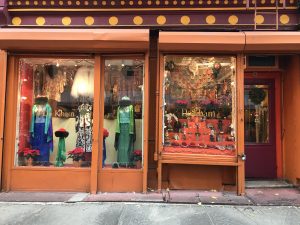
The storefront of Do Kham
They have been open for over 30 years. The interior of the shop is covered with all types of articles of clothing, ranging from Tibetan, Bhutanese, Nepalese to Indian clothing, accessories, and jewelry. With the help of the store owner, we were able to identify the Tibetan pieces and learn about the different types of clothing and their functions. We also enjoyed learning about meanings and symbols behind each piece of Tibetan clothing and jewelry. Like many Tibetan clothing stores, clothing designs have become more modernized and manufactured in Nepal. Tibetan clothing has been adapting to the current global fashion trend.
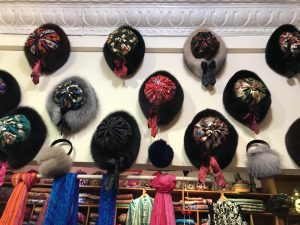
Fox fur hats hanging on the wall above a colorful array of scarves
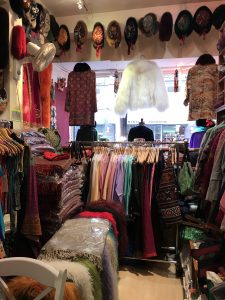
Lots of clothing inside the store! Racks filled with colorful clothing from Tibet, India, Bhutan and Nepal
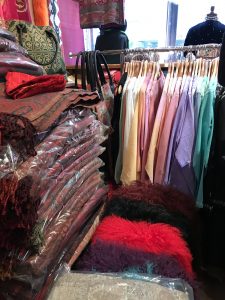
A corner with scarves, bags, and other vibrant pieces of clothing

Another rack! What a huge selection!
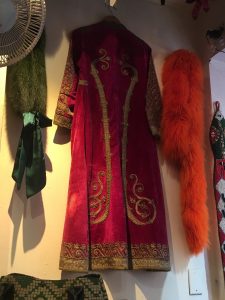
Lots of very beautiful clothing hanging on the walls! This particular piece is not Tibetan, but helps showcase the style of clothing that they carry in the store.

Another picture of the interior!
From Angela: I was very pleasantly surprised upon entering the store because there was so much clothing! It seemed like they had filled every possible space in their store, and they had much more in storage in the back. The owner told us that they had many things packed away since they are moving to a new location in the East Village soon, and even with things packed away the store was booming with clothes! Fun little side note: After looking at their Instagram, I saw that the costume department for one of my favorite TV shows “Blindspot” visited their store! I think it’s very cool that the media is going to a store like Do Kham and using authentic cultural clothing in their shows, since I think that’s a great way to celebrate a culture and spread more awareness. I’ll definitely try to spot the clothing once I get to the right episode!
From Nicha: I really liked all the clothing, jewelry, scarf and hat designs at Do Kham. I felt that I could walk around the city wearing any of the pieces and feel very stylish. I liked that Do Kham incorporates western fashion into their clothing designs, while maintaining Tibetan traditional clothing identity. I was surprised to learn that Do Kham has been open for 30 years, as it shows that Tibetan clothing has been popular among New Yorkers for a very long time.
CHUBAS
The first article of clothing we looked at was the chuba, the most common and traditional article of clothing in Tibet, a long robe with wide sleeves, tied at the waist with a woolen girdle or two cloth belts. It is also a Tibetan national dress. This serves to shorten the skirt to a walkable length, and the upper folds of the chuba bunch up to form a large circular pocket which they use to store a variety of materials such as eating bowls or other small necessities. Men usually wear it with a pair of trousers and a stand collar shirt inside. Women wear a shirt with a stand collar inside.
Most chubas are made from wool, but nomads wear chubas made from hand-sewn sheepskin with the fleece facing inwards. On the other hand, Tibetans that live in towns usually wear a cotton or silk undershirt with long sleeves under their chubas, while nomadic Tibetans will typically wear nothing, and only wear sheepskin drawers in the winter under their chubas. The chuba is not usually worn completely over the chest, and is instead undone to allow the right shoulder and arm, and sometimes the entire chest, to show. The chubas we looked at at Do Kham all had a Mongolian wrap style, with buttons along one side of the garment.
While there are different ways of dressing in each region of Tibet depending on the history, culture and climate of that region, the most common method of dressing comes from Central Tibet.

For example, robes and dresses in Lhasa and Shannan Prefecture in the south of Tibet are thinner. Men merely wear double layered robes, while women wear slim robes in either light or dark colors. In contrast, Tibetans in the north, especially herdsmen, wear furry robes to protect themselves from the heat during the day and cold during night time. The loose and wide sleeves allow Tibetans to remove their sleeves and tie them at their waists while they are working, and putting them back on during the night. Furthermore, pastoral women like to wear vibrant colors clothing.
Married Tibetan women also wear an apron, made from bangdian, as a marker. Bangdian is thin and delicate. Although women’s aprons were traditionally worn by married women only, nowadays both married and not married women wear aprons outside their robes. They decorate their aprons with five contrasting colors: blue, red, green, yellow and white. These color strips of bagdian are woven and dyed, and symbolize sky, earth, rivers, gods and clouds, respectively.
These days Tibetan people wear a modern version of the chuba. Influenced by global trend, modern chubas, especially women chubas, have become a lot narrower, though still covering up every part of the body. Chubas have also become a symbol of Tibetan resistance against Chinese control as well as a materialized Tibetan traditional and cultural identity. Lhakar movement or White Wednesday Movement, a nonviolent protest that started to resist China’s control of Tibet and assimilation into chinese culture, uses Tibetan traditional clothing, especially chubas, as a mean to show their political voices. Along with chubas, Tibetan food, Tibetan language and other cultural and national identities, such as their respect and faith in the Dalai Lama, are also practiced by Tibetans both in Tibet and all over the world. From merely a traditional dress, chuba has become one of the agents demanding for political change.


From Do Kham (left): A dark, thick chuba. This one is made from regular sheep’s wool, but in Tibet it would have been made of yak wool. As previously mentioned, this chuba features buttons along the side. From google image (right): Girls wearing vibrant colors modern chubas

From Do Kham: This large brown chuba with gold embroidery is something a man would have worn in Tibet 100 years ago, and again features a wrap front closure. This would have been worn for a special occasion such as New Years.
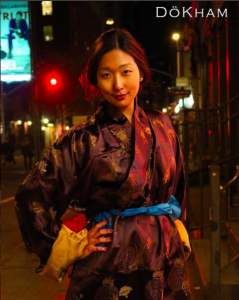
From the Do Kham instagram: How the brown and gold chuba would have been worn.
NON-CHUPA CLOTHING
Tibetans tend to be conservative in their clothing, and in modern times Western clothing styles have found their way into the region. This Western influence indicates a new perspective of Tibetan modern society and cultural expression. In traditional garments, women tend to wear dark-colored wrap dresses over a blouse. Men and women wear long sleeves even during the summer when the weather is very hot.
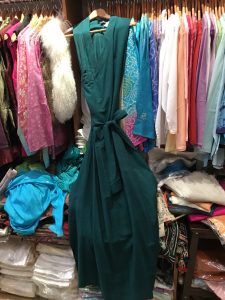
From Do Kham: A simple modern Tibetan dress in central Tibetan style. This one was made in India, but the Do Kham store also makes some themselves. This is the type of dress that would have been worn with a long-sleeved blouse underneath.
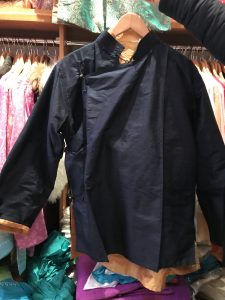
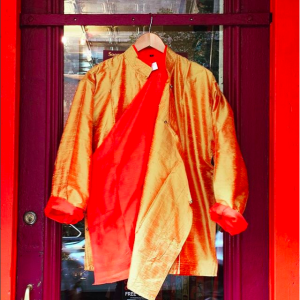
From Do Kham (left) and their instagram (right): This is the most common style of Tibetan men’s shirt. Like the chuba, this silk piece features the Mongolian wrap style closure, with buttons along one side. Some shirts have two piping pieces on the shoulder, while this one only has one. The shirts would have been worn one at a time, not layered like pictured.
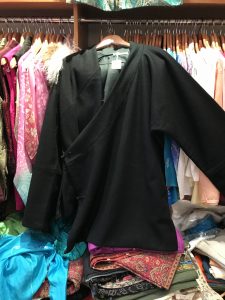
From Do Kham: A thicker jacket/shirt worn by men.

From Do Kham: These scarves in the bottom of the picture are from India, but the store owner noted that while these are not Tibetan, most Tibetan stores will carry these scarves.
Clothing materials were also symbolic in the past. A poor person or a deserter would wear fox skin clothing, while a wealthy or a war hero would wear tiger skin clothing. In addition, pulu, made of wool, and cotton are currently quite popular in Tibet as they can both be worn in summer and winter. At the present time, there is no discrimination on clothing material between any classes. One can wear anything that fits their sense of fashion, including fox skin or fox fur. The lack of symbolism of class status in clothing demonstrates that there is more social equality in modern Tibetan society.
HATS
Hats are popular in Tibet because of the region’s cold weather, windstorms, and strong sunshine. Hat styles vary according to function, but also indicate status and region. The most common hat for men and women within Tibet is the four-edged golden thread hat, which features a felt interior lining, and is decorated with golden silk and silk ribbon. In cold areas of Tibet, fox fur hats are popular with nomadic people, and are designed to protect the wearer from the harsh cold. The brim of the hat is long enough to the stretched to the shoulder to further protect the wearer, and all fox fur hats are handmade with herbs.

The hats in the store are made by the store owners, and are modeled after Tibetan style hats. These hats are made with fox fur, and feature a silk brocade in the center. The silk typically comes from China or India. There are also hats with a droopier silk brocade right in front of the counter (which we unfortunately did not photograph) that are very popular in Tibet right now.
From Angela: I was surprised when I saw these Tibetan hats because they reminded me of traditional Chinese hats that I have seen in various Chinese historical dramas based in the era of dynasties in China. Though the ones I have seen are much thinner and more decorative (possibly for aesthetic purposes of the TV show), they have a similar general shape and structure. The hats could have drawn inspiration from each other, since China and Tibet are relatively close.
From Nicha: Due to extremely different climate between Tibet and Thailand, traditional farmer’s hats from Thailand do not resemble Tibetan hats at all. Rather than using hats to protect from the cold, Thai farmers in the past used hats to block out the sun when they worked in paddy fields. They are made of ola palm leaves and bamboo, as they are good for sweating cooling.

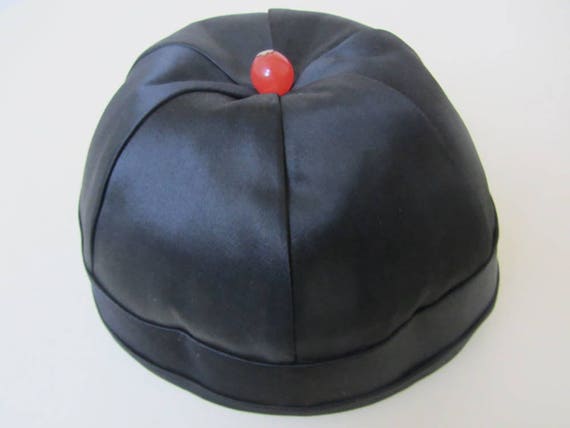

Side by side comparison of the Tibetan fox fur hat (left), a traditional Chinese hat (middle), and a traditional farmer’s Thai hat (right)
HEADDRESS
The most unique and traditional Tibetan head decoration for women is a headdress called bazhu. Bazhu is strapped with red pulu and decorated with either pearl, coral, or sewed. The styles of bazhu also differs across regions. Bazhu in Lhasa has three twigs tied on top of the head flatly and two twigs pointing forward. Bazhu in the south is instead arched.
In the past, bazhu also portrays social status and maturity. Upper class women wear pearl bazhu, while women from middle class can only wear bazhu made from coral. For a girl, wearing bazhu for the first time also indicates her transition from being a girl to a lady.


From Nicha: The designs and meanings behind the headdress intrigued me. In Thailand, headdresses are merely worn during traditional Thai dances and have no significant meaning. While Tibetan headdresses have bright colors and are decorated with big gems, Thai headdresses are gold and pointy, as well as adorned with only small silver simulated gems.
EARRINGS/JEWELRY/MALAS
Most Tibetans wear their hair long or in a braid wound around their heads with a pattern of smaller braids, while the lamas and some laymen shave their heads. Their hair is sometimes used to secure a conical felt hat, whose shape depends on which district they come from. In the left ear they wear a heavy silver ring that is decorated with a large coral or turquoise ornament, which we found at the Do Kham store.
The most common Tibetan ornaments are delicately designed as well as having meanings. They typically feature yak bones or Tibetan silver and have vibrant colors, such as bright red and light blue. The finer crafts of Tibet feature irregular shapes because of the natural quality of the materials, and the designs are usually derived from religious beliefs. Genuine jewelry made from Tibetan silver, which is 92.5% pure, are handmade by silversmiths with hammers and chisels, and each piece is unique. Most Tibetan silver bracelets are carved with a six syllable mantra “Om Mani Padme Hum,” which means that one can possibly achieve The Jewel in the Lotus or Buddhahood. It is also believed to protect the wearer by eliminating disease, prolonging life, and increasing wealth. Amulets (third picture below) are often boxes inlaid with precious stones and contain images of Buddha.
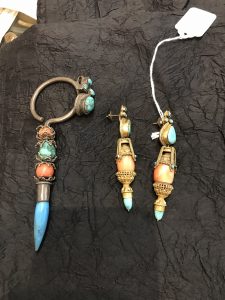
From Do Kham: Antique earrings featuring the aforementioned turquoise embellishments.
As Tibetans value their ornaments according to its size and color, jewelry is relatively big. This largeness is exemplified in the earring on the left. It would have been worn over the ear and tied in place with a string. The extensive use of turquoise in both earrings and bracelets as shown below is due to the Tibetans’ view that turquoise has healing qualities and can offer protection. Additionally, turquoise is believed to signify the owner’s health or emotion. The color fades when its owner is sick or sad, while becoming more saturated when its owner is healthy or happy.
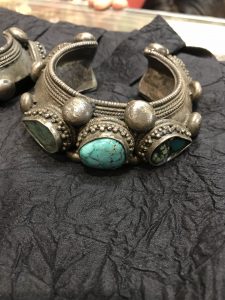
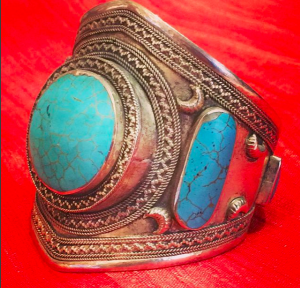
From Do Kham (left) and their instagram (right): An antique bangle & turquoise and silver cuff
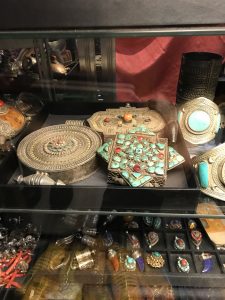
From Do Kham: Amulet boxes that would have been worn as accessories by women
Malas or prayer beads as shown below are also very popular among Tibetan Buddhists, as the Tibetans walk around wearing malas. With over a thousand year of history, malas are used to recite prayers or chants called “mantras” repeatedly, especially during meditation, among Tibetan, Chinese, and Indian Buddhists. Again, turquoise featured in malas has a significant meaning. It represents knowledge and spiritual journey. Similar tiger’s eyes or the brown beads are considered to promote peace, friendship and harmony in the society.
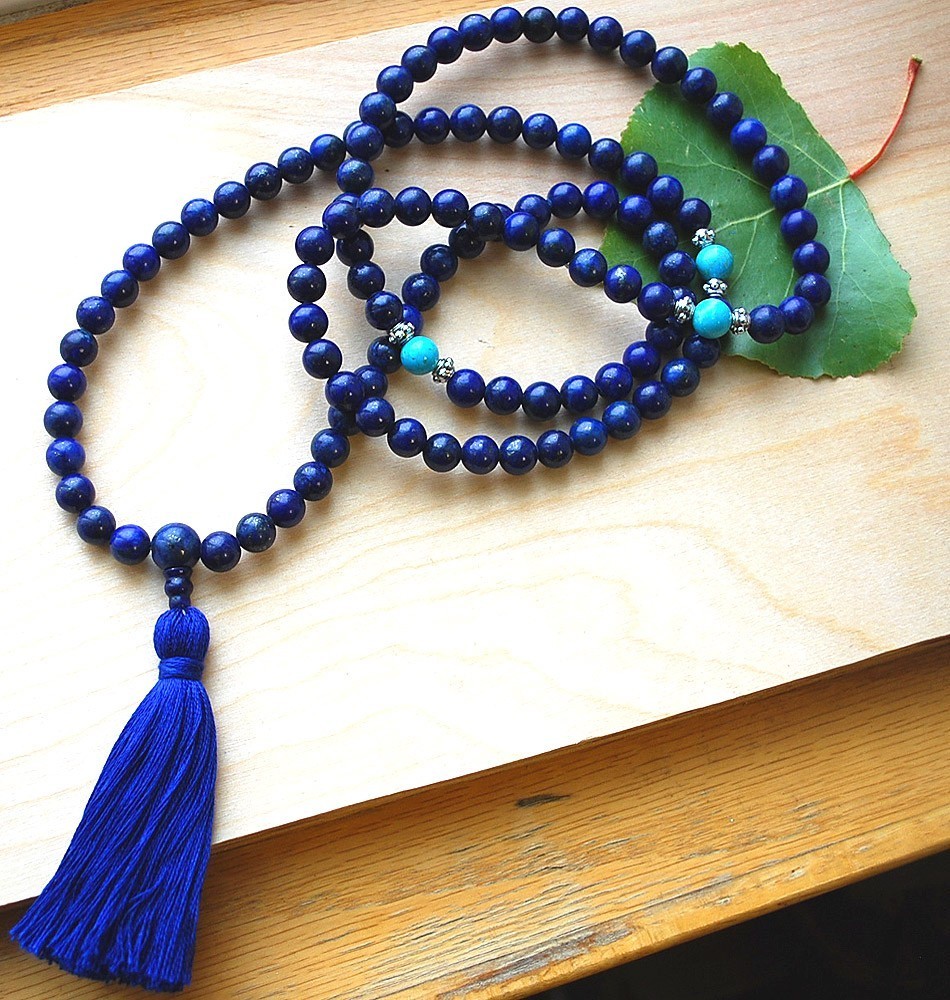

SHOES
Tibetan shoes are delicately embroidered and handcrafted. With a history of over 600 years, Tibetan boots, traditional shoes of Tibet, show the progress of Tibetan aesthetic and talent of the Tibetans. Both left and right pairs look the same without curves. There are three types of shoes classifying by materials: cowhide, corduroy and pulu. Similar to jewelry and clothing, shoes also have significant meaning. In the past, shoes styles indicate social status. Tibetan boots, which are called sumba, are limited to wealthy and aristocratic people.
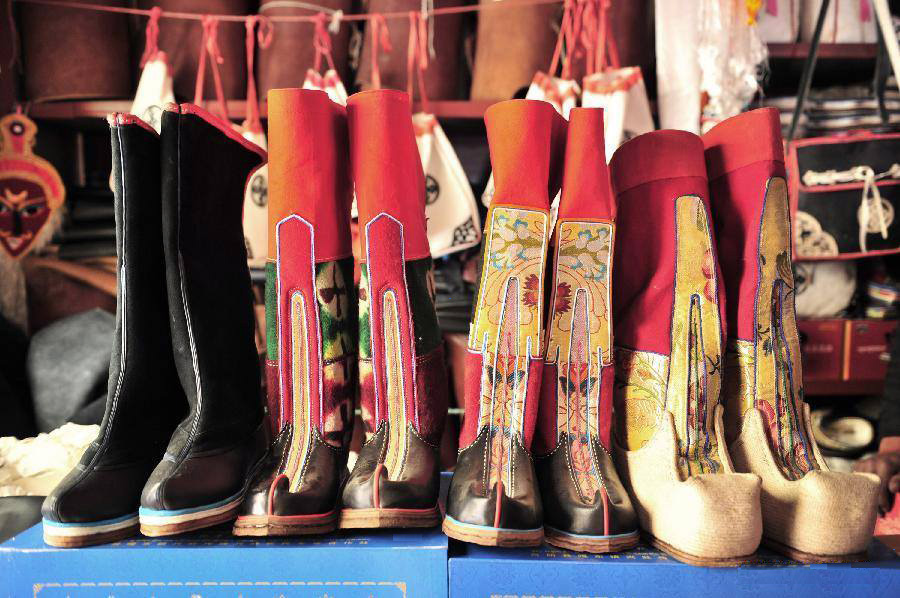
From google image: Traditional hand-made Tibetan boots
Nowadays sumbas can be worn by anyone, including men and women of all ages. They are made of tweed and the soles are made from oxhide. Most sumbas are black with varying embroidered patterns such as dragon and snake. However, the fineness of the patterns still reveals the social status and profession of the owner. Religious people instead wear sumbas that are made of satin or wool, while monks wear Gyiachin shoes. Gyiachin shoes again have religious messages as well as meaning rainbow in Chinese. As sumbas are comfortable and practical, Tibetans as well as other fellow nationalities wear them in their day to day life.
Like clothing, boot styles vary across regions. Combining striking boots designs from different areas, Lhasanese boots have rich colors and are the most fashionable. Boots made in the south are refined, while boots made in the North are more simple and practical.
MANDALA STORE
We also visited the Mandala Tibetan clothing store at St Marks. Due to the current fashion market and scale of production, Mandala store had mostly Indian and Nepalese clothing. One garment the owner from Tibet showed us was a Tibetan shirt made in India by a Tibetan refugee.

The exterior of the Mandala Tibetan store in St Marks.
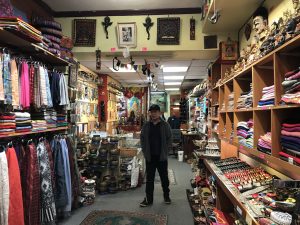
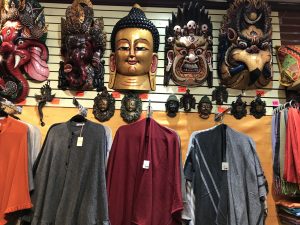
The interior of the Mandala Tibet store.
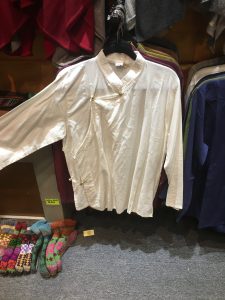
This long sleeves shirt is made by Tibetan refugee. Long sleeves shirt are usually worn inside the robe.
Works Cited:
China Odyssey Tours. “Tibetan Culture.” Accessed December 2, 2017.
https://www.chinaodysseytours.com/tibet/tibet-culture.html.
Dicky Yangzom. “Clothing and social movements: Tibet and the politics of dress.” Taylor &
Francis Online. Accessed December 11, 2017.
http://www.tandfonline.com/doi/full/10.1080/14742837.2016.1213163.
Gem Select. “Tibetan Gemstone Jewelry.” Gemstone Articles. Accessed December 9, 2017.
https://www.gemselect.com/other-info/tibet-gemstone-jewelry.php.
Hays, Jeff. “Tibetan Clothes, Jewelry and Ideas about Beauty.” Facts and Details. Accessed
December 9, 2017.
http://factsanddetails.com/china/cat6/sub35/entry-4437.html#chapter-9.
Tibet Vista. “Tibetan Hats.” Accessed December 2, 2017.
https://www.tibettravel.org/tibetan-people/tibetan-hats.html.
—-“Tibetan Ornaments, Tibetan Jewelry.” Accessed December 2, 2017.
https://www.tibettravel.org/tibetan-handicrafts/tibetan-ornaments.html.
Wikipedia. “Tibetan Culture.” Accessed December 2, 2017.
https://en.wikipedia.org/wiki/Tibetan_culture#Clothing.